

Target crop
Plants should continue to exhibit uniform growth following delivery from the propagator.
Target root zone
A successful start for the plant is determined by good root development which should remain confined to the block. Attention should be given to developing as many pin roots as possible to enable fast rooting in as soon as slab contact is required.
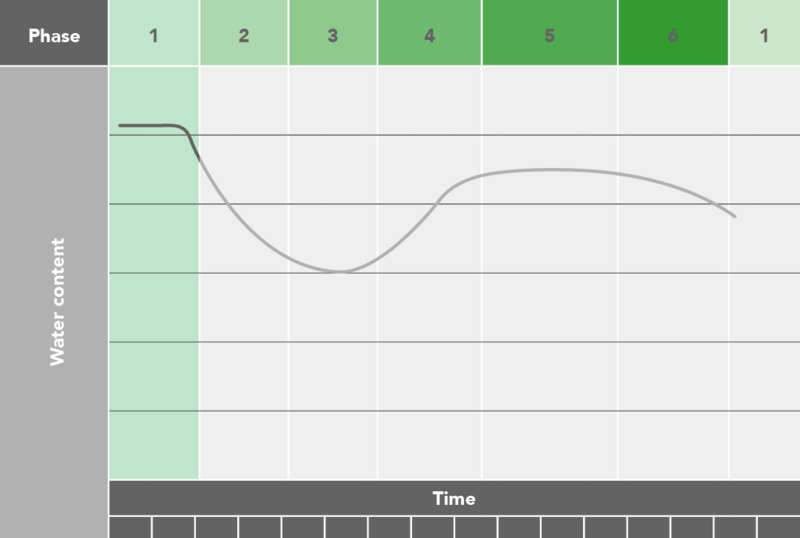
Start of phase
Plants arrive into greenhouse
End of phase
Rooting in
Objective phase
Continue the uniform development of a strong generative plant with good formation of the first and second clusters.
Target crop
Uniform growth should continue and the leaf area should increase to enable the plant to intercept as much radiation as possible. Truss development should remain strong and generative with good flower and pollen formation.
Target root zone
The pin roots should grow easily out of the block and uniformly into the substrate. It is important to supply enough water and nutrition to the blocks until the plant can rely on the available water in the slab.

Start of phase
Rooting in
End of phase
Roots have penetrated substrate by several centimeters
Objective phase
Fast and uniform rooting in, so that the roots are penetrating the growing media in line with the plant size.
Standing plants on the side of the plant hole focuses strength into the first and second clusters and keeps the correct generative balance in the crop. Just like in propagation, each irrigation you provide will result in a vegetative plant reaction. Therefore while the plants are stood beside the plant hole limit the number of irrigation sessions by steering on block WC%. It is best to let the block dry down to 40 - 45% before re-saturating it back to 80% (see reference table). Here you will realize the benefit of the slow uniform dry down from the Plantop blocks giving you the extra possibilities in generative steering.
If you have a GroSens system installed placing the sensor in the propagation block during this phase can aid your decision making on when to irrigate. To position the sensor first remove the stainless steel plate and insert the pins into the block. Watch the video below on how to do this correctly.

We are often asked when is the right time to transfer the block onto the slab? The simple answer is when the irrigation frequency (vegetative action) is leading and you are no longer ‘steering’ the plant! Of course this will be dependent on block size and the number of heads per block. Larger blocks 10 x 15 cm with one plant (2 heads) will offer longer generative control possibilities compared to 10 x 10 cm with two plants (4 heads).
You have two options for cutting the drain holes
Option 1
Pre-draining the slab by puncturing the plastic wrapper with a small hole just above the seam will create a small reservoir of water at a uniform height in each slab throughout the greenhouse. This layer of water ensures that the propagation block will remain sufficiently & uniformly wet so in the first 48 hrs after planting (even if you have previously stood the plants beside the plant hole) only 1 or at most 2 irrigation sessions will be required to stimulate root penetration into the slab (applies to Plantop only). Watch the video below on how to do this correctly.

Stop irrigating from the moment the plant is rooted 2 - 3 cm into the underlying slab & until the final drainage hole is cut which will be after 4 - 7 days. Ideally the final drain hole should be made by cutting along the length of the plastic seam with scissors or by cutting one hole on the side of the slab at its lowest point.
You will find it easier to cut the drain hole while there is still excess water in the bottom of the slab pushing the side-walls of the plastic foil outwards.
Option 2
If you wish to cut the drain holes directly first drain excess water from the slab by making a small puncture just below the seam. Return to the slab once it is drained. Ideally the final drain hole should be made by cutting along the length of the plastic seam with scissors or by cutting one hole on the side of the slab at its lowest point. Watch the video below on how to do this correctly.

| Start time | Block weight <300g 10 x 10 cm <350g 10 x 15 cm | ||||||
| Stop time | -2.0 - 4.0 hrs before sunset | ||||||
| Target day level WC | Block weight >450g 10 x 10 cm >500g 10 x 15 cm | ||||||
| Moment 1st drain | Not applicable | ||||||
| EC drip | 3.5 - 4.5 mS/cm | ||||||
| EC block | 4.0 - 11.0 mS/cm | ||||||
| 24 hr drain | Not applicable | ||||||
| Decrease WC overnight | Maximum 20% block WC% | ||||||
| Night irrigation | High pipe temp (>60°C) and if blocks are expected to be too dry by following sunrise | ||||||
In propagation the Plantop block was typically irrigated when the block WC% reached 40%. The ebb-flood system raising it easily back to 80%. Between the irrigation moments the EC typically rising from 4.0 to 11.0 mS/cm. This prcoess of controlled irrigaiton facilitated maximum generative plant development. This same approach should continue whilst the plants are stood beside the plant hole. For guidance on when to irrigate you can use the GroSens system. Simply remove the metal plate and insert the GroSens sensor into the block. Optimising the irrigation strategy at this stage will encourage more ‘pin roots’ to develop within the block. It will also ensure the plants continue to grow in a controlled, uniform way thus stimulating the development of strong flowers. Remember having a uniform and slow decrease in WC% between irrigation sessions whilst standing the plant besides the plant hole allows you to lower the frequency of irrigation, thereby increasing your ability to steer the crop in a generative direction.
| Start time | +2.0 hrs after sunrise | ||||||
| Stop time | -2.0 - 5.0 hrs before sunset | ||||||
| Target day level WC | Slab >75% Block >50% | ||||||
| Moment 1st drain | Not applicable | ||||||
| EC drip | 3.5 - 4.5 mS/cm | ||||||
| EC slab | 3.5 - 4.5 mS/cm | ||||||
| 24 hr drain | Not applicable | ||||||
| Decrease WC overnight | Not applicable | ||||||
| Night irrigation | High pipe temp (>60°C) and if blocks are expected to be too dry by following sunrise | ||||||
Before planting, it is essential to fully saturate all the slabs with nutrient solution for at least 24 hours before the drain hole is cut. This ensures that even the fine pore spaces between the NG2.0 fibres are filled with water. There are two ways to cut the drain hole. Watch the video below on how to do this correctly. To ensure good re-saturation in combination with a simple irrigation strategy throughout the duration of the cultivation you are advised to cut one drain hole per slab. However if your gutter profile is uneven you can make an additional drain hole at the lowest point of the slab. Remember with Grodan Vital it is perfectly safe to recycle the drain water from the moment the drain holes are cut.
Target crop
Work on plant development and increasing the leaf area to capture the available radiation and keep the required vegetative – generative balance in the plant relative to the fruit load and light levels.
Target root zone
Establish complete root penetration in the entire volume of the growing media. This will enable the plant to take up all the water and nutrition it will need for maximum summer production and quality.
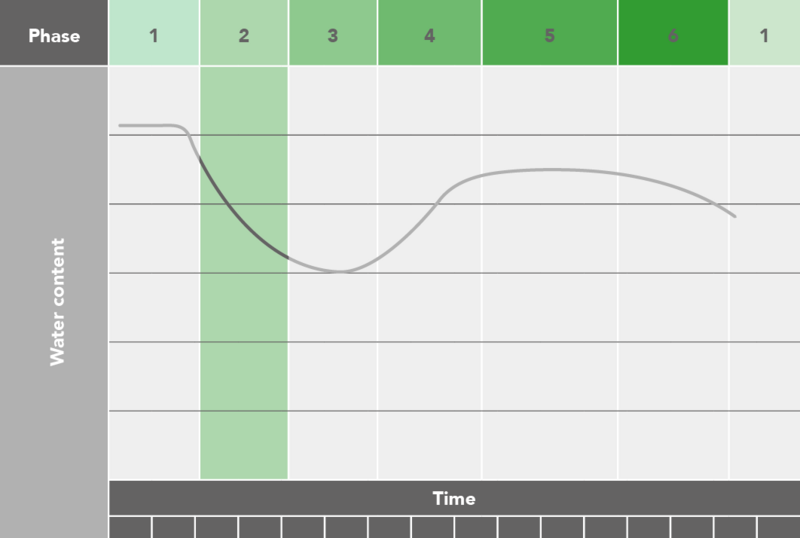
Start of phase
Roots have penetrated substrate by several centimeters
End of phase
4th truss is flowering
Objective phase
Continuation of uniform and controlled plant development and the realisation of a root system that fills the entire volume of the growing media.
The crop is now rooted into the slab so ensure your GroSens sensor is positioned in the slab correctly. Watch the video below on how to do this correctly.
Moving forwards, until cluster 7 or 8 is flowering the required minimum decrease in WC% overnight can be determined by the following rule-of-thumb: the number of the flowering cluster plus 2%. So if you’re flowering on cluster 4 + 2% = 6% minimum decrease in WC% overnight. If the decrease is less than this please look to your start or stop times of irrigation and cross check these with the advised values in the reference table.
Although the shortest day of the year is just behind us the daily radiation sums are still low. On brighter days you will need to give enough water for growth. Please remember, in this phase there is a distinct difference between controlled generative growth and the creation of a weak crop, which you interpet as generative.

In the coming weeks you will clearly experience the superior functional performance of Grodan growing media with respect to EC control. The generative balance in the crop should be maintained by late start & early stop times and by steering toward a stable but structurally high substrate EC. To ensure EC stability in combination with a short irrigation day ensure the irrigation session size is 4.0 - 4.5% (ml/m²) of the substrate volume (l/m²). Again your GroSens system is the perfect tool to monitor how substrate EC is developing day to day.
To get an appreciation of the uniformity of WC% and EC between the slabs the GroSens handheld system or the Reader with a GroSens sensor in ‘kit mode’ is a perfect tool. Watch the video below on how to do this correctly.

| Start time | +2.0 - 3.0 hrs after sunrise | ||||||
| Stop time | -2.0 - 4.0 hrs before sunset | ||||||
| Target day level WC | 60% by flowering 4th cluster (min WC 55%) | ||||||
| Moment 1st drain | +4.0 - 6.0 hrs sunrise | ||||||
| EC drip | 3.5 - 4.0 mS/cm | ||||||
| EC slab | 6.0 - 9.0 mS/cm | ||||||
| 24 hr drain | 0 - 25% | ||||||
| Decrease WC overnight | 6 - 10% | ||||||
| Night irrigation | High pipe temperature (>60°C) and decrease WC >10 % | ||||||
The open fibrous structure of Grodan Vital NG2.0 facilitates rapid rooting into the growing media which is required for uniform plant development. For vegetative – generative plant balance the irrigation strategy must be in line with the climate and screening strategy. To promote optimum horizontal root formation your objective should be to gradually lower day level WC% from 80 - 85% to 60% by the time the 4th cluster is flowering. This will help the crop fully penetrate to entire volume of the growing media providing the basis for water and nutrient uptake in the summer. This will result in stronger more vigorous plants. Accepting a higher EC range in slab in line with the low light levels during this phase will contribute towards easier generative steering.
Target crop
Growth should remain constant and uniform. The 24 hrs temperature should be adjusted to the light levels to ensure optimum partitioning of available assimilates for plant and fruit growth.
Target root zone
Root quality and activity should be retained to ensure controlled and uniform re-growth of the crop from the harvest of the first clusters. The decrease of WC% during the night will provide a good indication for the level of plant activity during the day.
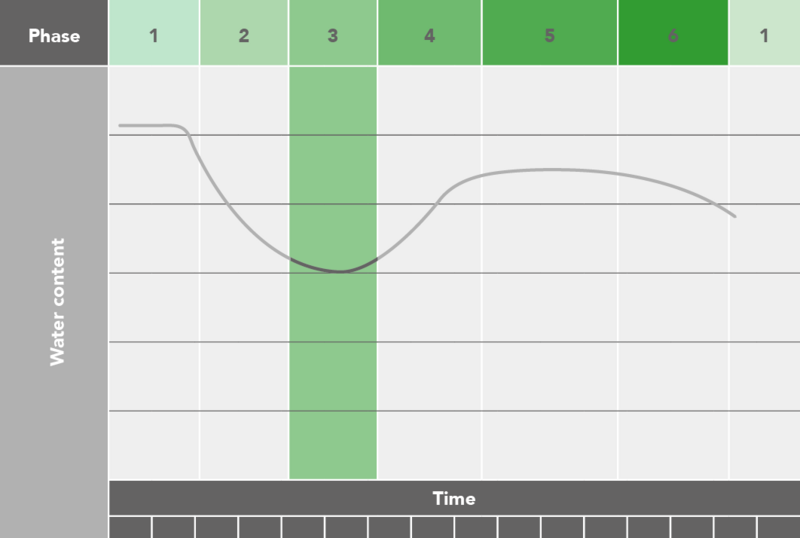
Start of phase
4th truss is flowering
End of phase
After first harvest
Objective phase
Avoid shocks in development by retaining the right balance in fruit load and growing power in the plant to ensure optimum cluster development. The combination of harvest of the first fruits and new fruit setting (as fruit load continues to increase) must be in line with assimilates supply which is variable and strongly depending on the weather.
The fourth or fifth cluster is now flowering. Fruit on the first and second clusters is increasing in size and irrigation is now required to level EC and raise the WC% of the growing media. But do not think that control over EC comes with “flushing” the slabs. This will result in a very vegetative crop reaction, especially the extensive use of the climate screen. Maintain generative plant development with a generative irrigation strategy, i.e. a late start, early stop and by using large irrigation volumes in the region 3 - 4% of the substrate volume/m2. Maintaining a strong crop is the best way to control the EC of the growing media but above all do not “chase EC”. This implies excessive irrigation and loss of plant balance and root quality.
| Start time | +2.0 - 4.0 hrs after sunrise | ||||||
| Stop time | -2.0 - 4.0 hrs before sunset | ||||||
| Target day level WC | 60 - 65% | ||||||
| Moment 1st drain | +4.0 - 5.0 hrs sunrise | ||||||
| EC drip | 3.0 - 3.8 mS/cm | ||||||
| EC slab | 4.0 - 5.5 mS/cm | ||||||
| 24 hr drain | 15 - 30% | ||||||
| Decrease WC overnight | 6 - 10% | ||||||
| Night irrigation | If decrease WC% >10% | ||||||
The growth of new roots and root tips should be encouraged by adjusting the start and stop times of irrigation, especially on darker days. The irrigation and slab EC’s are important steering tools to maintain plant balance and fruit quality in this phase. The NG2.0 technology allows the irrigation EC to be maintained sufficiently high while the slab EC remains stable with minimal drain volumes. This makes it possible to start irrigation later and stop earlier especially on the darker days. Importantly it means that you do not have to “chase” the EC of the growing media by applying additional irrigation water and creating unnecessary and unwanted vegetative crop development.
Target crop
Prepare the crop for summer creating the right balance as the plant load and production continue to increase.
Target root zone
To support increasing transpiration levels the root zone environment needs to be prepared. The recommended WC% and EC levels for late spring and summer should now be realised.
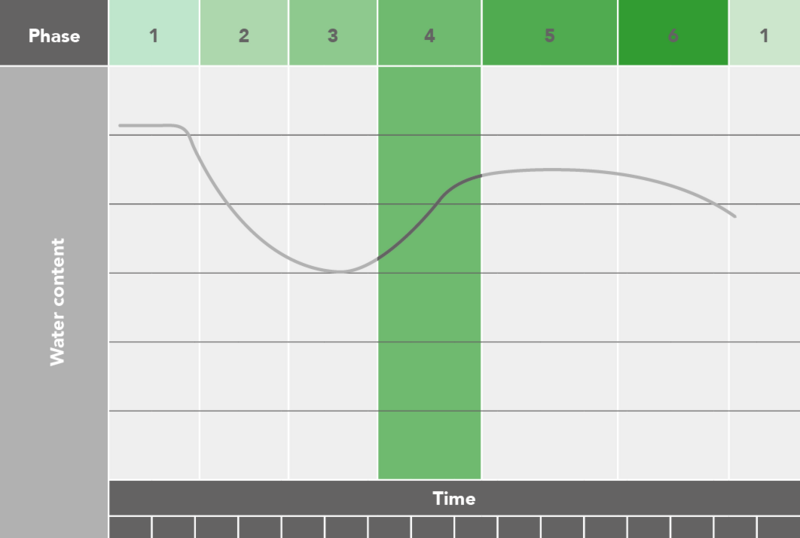
Start of phase
After first harvest
End of phase
Crop is getting into stable production
Objective phase
Realise controlled and uniform re-growth of the crop following the first harvests.
First harvests have now been taken and solar radiation is increasing rapidly towards the longest day.
The warm sunny weather will accelerate crop growth and development but please be aware that the real change from vegetative to generative development comes at quite high radiation levels, (>600 W/m²) so you still need to use tools like EC and irrigation start and stop time to steer the crop towards (sufficient) generative development.
Irrigation EC should be held to at least 3.0 mS/cm. A slight decrease in set point can be programmed, especially when drain EC levels are trending upwards, but the EC decrease on radiation shouldn’t be more than 0.3 - 0.5 mS/cm².
Stop time of irrigation will vary according to the evaporation, and thus, mainly on the solar radiation at the end of the day. Irrigation should continue until radiation falls below 250 - 300 W/m². leaving 2 - 4% decrease in WC% to sunset. Irrigating too late increases the risk of cracked fruits.
| Start time | +1.0 - 3.0 hrs after sunrise | ||||||
| Stop time | -2.0 - 3.0 hrs before sunset | ||||||
| Target day level WC | 65 - 75% | ||||||
| Moment 1st drain | +3.0 - 4.0 hrs sunrise | ||||||
| EC drip | 3.0 - 3.5 mS/cm | ||||||
| EC slab | 3.5 - 4.5 mS/cm | ||||||
| 24 hr drain | 20 - 35% | ||||||
| Decrease WC overnight | 6 - 10% | ||||||
| Night irrigation | Only if additional vegetative steering is required | ||||||
Grodan Vital combines the elements of safety and security as the slab should be easy to re-saturate to 65 - 75% day level WC% in this phase. This will provide an adequate and stable water buffer which is essential for good summer production. Due to the NG2.0 fibre technology and the open fibrous structure the slab has a fast reactivity on EC in periods of variable weather it is therefore easy to maintain the target slab EC in combination with a simple irrigation strategy resulting in maximum growth and development of the crop.
Target crop
Vegetative or generative steering will depend on the condition of the crop. The crop should remain strong to cope with large and extreme fluctuations in weather conditions. The set speed should match the harvest speed to maintain constant fruit load.
Target root zone
Water uptake should match the needs of the crop for maximum cooling potential to create a good climate inside the greenhouse. Good root penetration throughout the entire volume of the growing media realised in Phase 2 will help the crop to cope with extreme weather conditions.
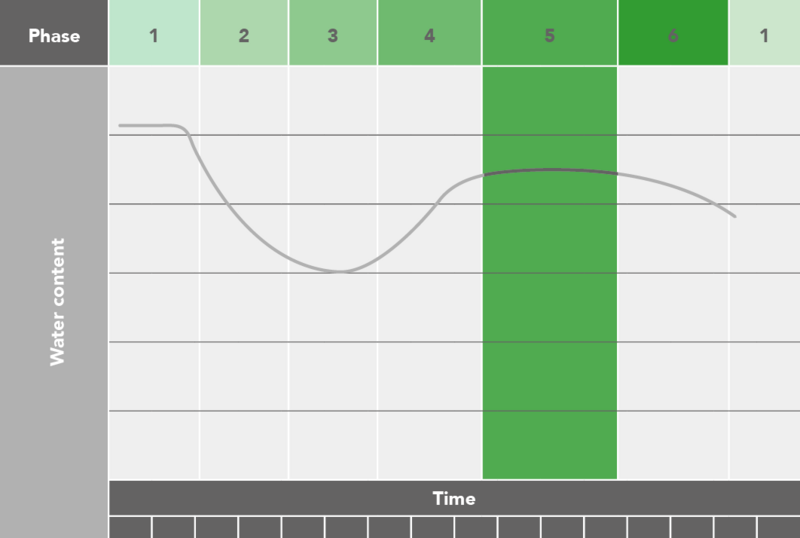
Start of phase
Crop is getting into stable production
End of phase
Head is taken out of the plant
Objhective phase
Maintain maximum plant vigour and production potential by keeping plant and root quality in excellent health.
EC control during this pahse is crucial. The GroSens sensor is an excellent tool to assess if the irrigation strategy needs adjusting. The standard graphic should contain WC%, EC, radiation sum (J/cm²) and radiation intensity (W/m²). If scaled correctly it is very easy to see relationships between these data points and answer the following questions:
You can check these values with the guidance provided in the reference table.
Irrigation capacity:
Insufficient irrigation capacity is the major reason for a rising EC in this phase. For adequate EC control in the growng media your irrigation capacity should be able to deliver at least 1.2 litre /m² per hour in this growing phase. You may only need this for 2 or 3 weeks of the year but in hot dry summers you’ll need it. Starting irrigation early and stopping too late, as compensation for a low irrigation capacity, achieves nothing! You will still find the computer on “wait” in the middle of the day and an increasing substrate EC will be visible on your GroSens graphic. Consequently you’ll in an attempt to avoid Blossom End Rot you will continue to reduce the drip EC. As a result plant vigour will be lost along with valuable production in the autumn.
| Start time | +1.0 - 3.0 hrs after sunrise | ||||||
| Stop time | -2.0 - 4.0 hrs before sunset | ||||||
| Target day level WC | 70 - 75% | ||||||
| Moment 1st drain | +3.0 - 4.0 hrs sunrise | ||||||
| EC drip | 2.8 - 3.3 mS/cm | ||||||
| EC slab | 3.5 - 4.5 mS/cm | ||||||
| 24 hr drain | 20 - 40% | ||||||
| Decrease WC overnight | 6 - 10% | ||||||
| Night irrigation | Only if additional vegetative steering is required | ||||||
The re-saturation properties of Grodan Vital will provide the optimum water buffer for summer production, especially on days of high radiation which demand maximum water uptake by the crop. The irrigation strategy can easily be adapted to weather conditions and plant demands resulting in a stable WC% and EC in the slab.
Target crop
Maintain strength and growing power of the plant and limit the ingress of disease in the crop as the light levels diminish towards final harvest.
Target root zone
Maintain a healthy and active root system and to keep the correct nutrient balance in the root zone. Ensure the irrigation strategy compensates for the rapidly changing transpiration levels. Maintain a stable and sufficient decrease WC% during night.
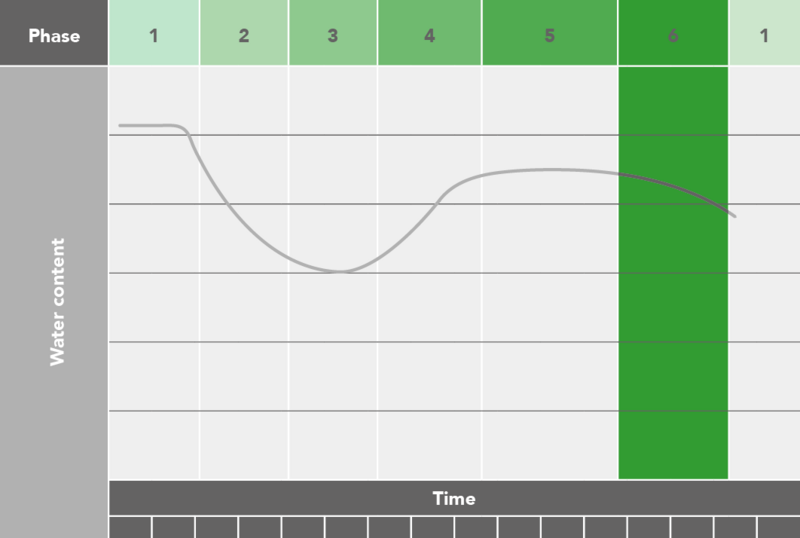
Start of phase
Head is taken out of the plant.
End of phase
When final harvest has taken place.
Objective phase
Keep the crop in a healthy condition and use the vigour to ensure production and quality is maintained right through to the last planned harvest date.
In order to keep the root system healthy good oxygen penetration is important. Therefore lower the irrigation frequency and the day level slab WC% will decrease slowly. To compensate for the lower irigation frequency increase the size of the irrigation volume per cylcle. Ensure the start and stop times coincide with the astronomical clock and gardually lower the day level slab WC%.
Pay attention to dark days with relatively high temperatures as the crop can evaporate more than the anticipated set radiation sum. On a sunny autumn day, the crop will only become active at +/- 100 J/cm². This is the moment for the 1st irrigation.
Often too much irrigation is given on dark days. The advice is to irrigate with minimum volumes on days >500 J/cm² and it is neither uncommon nor detrimental to the crop to achieve zero drain and the let the growing media EC increase. On days where the radiation sum exceeds 1000 J/cm² irrigation should be applied 2.5 to 3.0 times the radiation sum. Such days are appropriate for leveling slab EC between 11:00 – 13:00 hrs.
Stop irrigation on dark days up to 3.0 - 4.0 hours before sunset and target a steady decline in slab WC% overnight between 7 - 8%. Overall keep the irrigation EC >3.0 mS/cm especially when radiation <600 W/m² and consider the need for light reduction EC if these settings have been very reactive during phase 5.
| Start time | +2.0 - 4.0 hrs after sunrise | ||||||
| Stop time | -3.0 - 4.0 hrs before sunset | ||||||
| Target day level WC | 60 - 65% | ||||||
| Moment 1st drain | +4.0 - 6.0 hrs sunrise | ||||||
| EC drip | 3.0 - 3.5 mS/cm | ||||||
| EC slab | 4.0 - 5.0 mS/cm | ||||||
| 24 hr drain | 10 - 30% | ||||||
| Decrease WC overnight | 6 - 10% | ||||||
| Night irrigation | No | ||||||
A stable decrease in WC% during the night is most important to protect the root quality and keep the crop in the right generative balance. The easy drain characteristics of Grodan Vital mean that EC is stabilized in the slab especially when the total irrigation volumes are reduced on the darker days. The NG2.0 technology ensures an uniform distribution WC% over the height of the slab allowing the bottom layer to dry out sufficiently overnight preserving root quality until the final harvest has been taken.
We are a global leader in the supply of innovative stone wool substrate solutions for the professional horticultural based on Precision Growing principles.